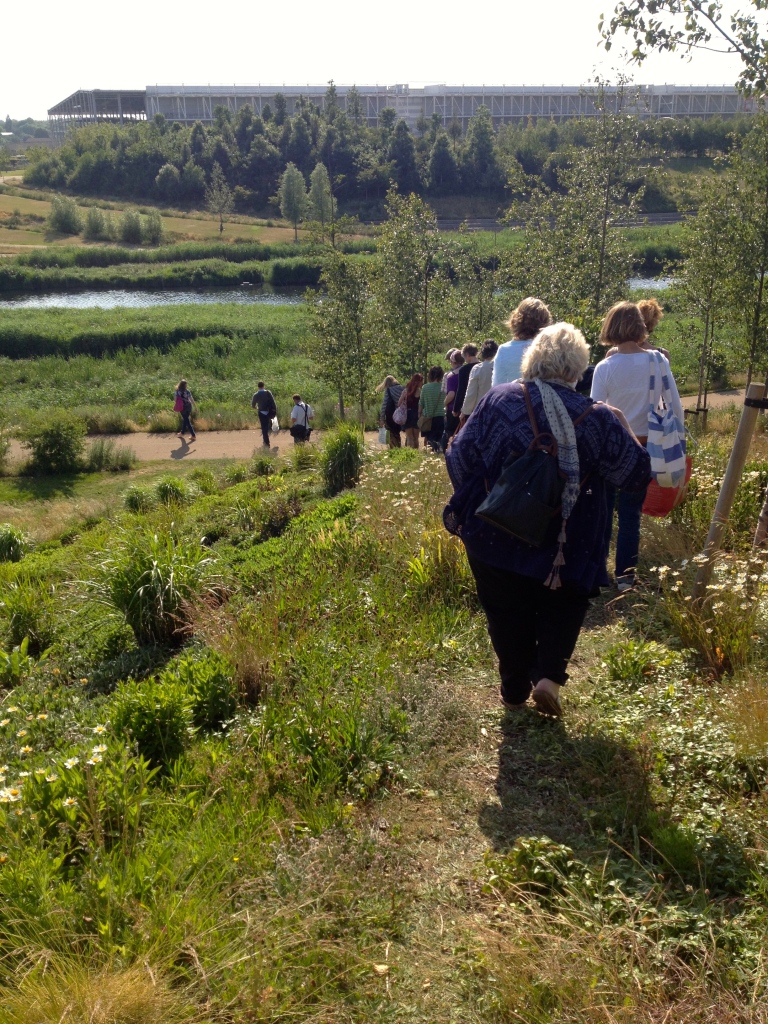A beautiful sunny June morning finds me at the Queen Elizabeth Olympic Park (QEOP). Waiting outside the aquatics centre a raucous bunch of fellow horticulturists formed. Excited not by also the pub meal but the tour of the park by Dr. Phil Askew, Project Sponsor Parklands and Public Realm at QEOP. Over thirty of us were in attendance from all walks of life in the horticultural world.

The location was Stratford, East London, where over one hundred hectares where many languages are spoken. From its industrious two hundred year history the land was a polluted wreck. So how was this site going to become one of the historic highlights of British Olympic history? The answer lies in lots of planning and a legacy which has and will allow the site to become a haven for wildlife and an open space for people to enjoy now the games are well and truly in the past.
Dr Askew explains that from the start the whole concept of the park was to have longevity unlike many other countries around the globe where vast fortunes have been spent on expensive stadiums which stand empty and unused. The olympic park has a well thought out 10 year legacy plan where temporary venue sites will be developed into leisure, education and housing. Wildlife takes a key role, with over half of the parkland designated for habitat. The park is to be open 24/7 and be part of the city creating a ’21st century Pleasure Garden.’
To develop the site was not an easy job. It took developers a good few years to transform two and a half kilometres of ‘unclean’ ground. Started in 2007 the huge clean up of heavy metals, oils, asbestos and even nuclear waste took place. Processed mainly on site, large soil hospitals were created where microbes broke some of this two million tonnes worth of matter down. Even so, the soil wasn’t a great standard and so is found beneath a membrane buried under a 600mm layer of clean soil, created and tailor made using a mix of green waste and crushed quarry washings. This allowed the fertility of the soil to be adjusted for many of the native species found growing on site.
Planting wise, there are twenty two ‘gardens’ within the park and five hectares of wild meadows where a ten-year maintenance contact with the landscape group takes place.

The south and busiest side is where most of the horticultural work takes place. Non native plants take you through the continents with random spacings. There are no specific planting plans, just a guide to how many plants should be in a square metre to create a natural look. Much research was done into this by Nigel Dunnett and his team, who is a professor in planting design based in Sheffield. In the middle is the classic planting style of Piet Oudolf where drifts of perennials and grasses merge into each other. Here armed with a smart phone you can download an application giving you much information about the plants themselves. You can find all the info at 2012 Gardens. 

To the north you will follow the River Lee into the landscape. It is here where you’ll find perennial native meadows and four to five beehives. In total there were over eighty-five thousand perennial plantings within the park. The key was to have flowers at eye level with foliage lover down. Some plants were sourced from national collections, such as Hosta Tall Boy which due to its non easy garden centre customer growth habit, had to be propagated and grown on by various contractors due to its unavailability. Both the native and non native plantings supply a rich variety of nectar to the bee community in London.

Plantings in the areas where the temporary venues were are called ‘stitch plantings.’ Just like thread holding fabric together, they join the park with the neighbouring suburbs and bring the building sites into the park as part of it. Their aim is to make these sites feel safer and cleaner and more welcoming as the continuing development evolves and expands. A mix of plugs, bulbs and seeds perform brilliantly dispersed with tree planters which will hopefully find a new home amongst the developments.

Once our tour had finished, I took particular interest in the rope and net course and proceeded to play with my hortic chums before a most welcoming pint at the Cow after a hot and sunny day it turned out to be. If you haven’t visited the park since the olympics, please do. If you have children they will love the play areas and for the adults the plantings are great! Many thanks to Dr. Phil Askew for his time and Gerald Abrahams for organising this All Horts tour raising money for Perennial and Greenfingers charities.






Great post Rocky, thank you for sharing your experience of the day with us! What a surprise that you managed to find some swings. I think I’m detecting a pattern!
LikeLiked by 1 person